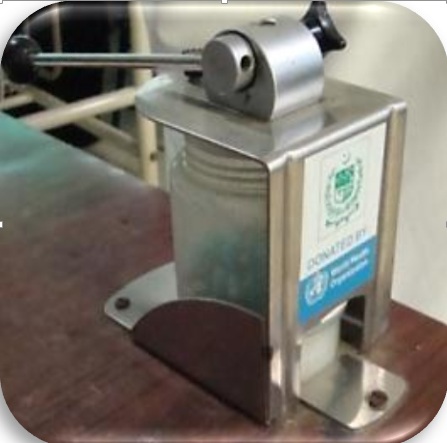WHO Pakistan in collaboration with the Health Foundation Pakistan, a nongovernmental organization, Pakistan Medical and Research Council and  Manual needle removers disable syringes Jinnah Postgraduate Medical Centre Hospital, Karachi, piloted an injection safety project to identify an innovative, cost-effective, replicable solution to break the transmission cycle of bloodborne infections by preventing the reuse of syringes by disabling syringes through a manual needle remover.
Manual needle removers disable syringes Jinnah Postgraduate Medical Centre Hospital, Karachi, piloted an injection safety project to identify an innovative, cost-effective, replicable solution to break the transmission cycle of bloodborne infections by preventing the reuse of syringes by disabling syringes through a manual needle remover.
Pakistan is among the top countries in which bloodborne infections are prevalent among the general population, with high transmission among the lower socioeconomic class of the population.
The national prevalence of viral hepatitis B and C stand at 7.8% with an estimated 12 million people suffering from this disease according to a national prevalence survey conducted in 2008. One of the major reasons for the spread of these bloodborne infections is the reuse of syringes. Major hospitals, such as the Jinnah Postgraduate Hospital in Karachi, are among the major sources of such medical waste that carry the risk of spread of these infections.
WHO Pakistan planned a pilot project with its partners to implement a mechanism to break this cycle of transmission by ensuring that each used syringe is cut safely and disposed off properly.
The pilot project, conducted between July 2011 and June 2012, was implemented at a tertiary care hospital in Karachi, Pakistan, and was carried out in four phases.
Phase 1: Situation analysis
A situation analysis using the WHO revised injection safety assessment tool (Tool C) tailored according to the facility, was carried out in 30 wards. Results showed that in 67% of wards syringes and needles were not disposed adequately and infectious waste (bloody swabs or dressings) were not being disposed in appropriate container in 77% cases. There were no puncture resistant containers in 80% of the wards. Sharps containers, where present, were accessible by the public in 93.3% cases leading to pilferage. Observation of injection practices showed that in 70% cases the injections were being prepared on a clean dedicated trolley or tray, but in almost 100% instances the provider did not wash his hands before preparing an injection. In 70% of observations no gloves were used while giving an injection. Syringes were recapped by the provider using both hands in 90% cases, resulting in accidental needle stick injury which was reported to be 30% by paramedics (6 months). In interviews with injection providers and supervisors it was revealed there was no injection safety, waste disposal guidelines in wards by the Ministry or the hospital in 93.3% cases,whereas 83.3% of the staff had not even received any formal training on injection safety in the last 2 years. Hepatitis B vaccination coverage of health care workers was (all 3 doses) 73.3%.
Phase 2: Training
Training sessions were conducted for doctors, nurses and janitorial staff in different sittings. Impact of training on health care workers was assessed through a pre- and post-test.
Phase 3: Implementation
Two needle removers and a training manual were given to wards under the supervision of a head nurse and a concrete pit was constructed in the premises of the hospital for disposal of the cut needles. Special advocacy sessions were held for the administration staff of the hospital who instructed the staff to comply with the new system and regulations.
Phase 4: Monitoring
Monitoring, which took place between January and July 2012, for accessibility showed that in 97% of wards the device was accessible to injection providers, the device in 96.5% of wards was working well showing good performance, adequate cleaning and maintenance was observed in 84% of wards (empty container in 93.1% and disposal of needles in needle pit in 96.3% of wards), 74.1% were lubricating the device and 40.7% cleaning with bleach before reuse.
Challenges
The challenges faced during the project included:
- lack of interest and apathy to the use of needle removers in wards along with tampering of devices in the first month of monitoring
- blockade of the needle insertion hole (technique)
- improper falling of needles in the container (failure to align the container properly)
- rusting owing to lack of proper cleaning of the blade (especially in cases of phlebotomy) and littering along with stolen lid of the pit.
Success
Stringent monitoring of needle removers and the pit combined with behaviour change modification of health care workers during the pilot project resulted in increased use of syringe cutters and sharps containers from 40% to 80%, and eventually to 100% by the end of six months. A major achievement was zero needle stick injuries in the monitoring period of the project, as opposed to 30% in the situation analysis.
Conclusions
For developing countries, such as Pakistan, a needle cutter may be the near perfect or an ideal temporary solution to isolate and disable sharps, such as needles attached to syringes, reducing needle stick injury and rendering hospital waste non-infectious, in order to reduce waste volume, especially in public sector hospitals and general practice clinics where standard sharps waste management is not being implemented according to international standards. Hospitals lacking an incinerator facility may also combat the cost involved in transportation to final disposal site by upgrading current practices and adopting innovative ideas.



